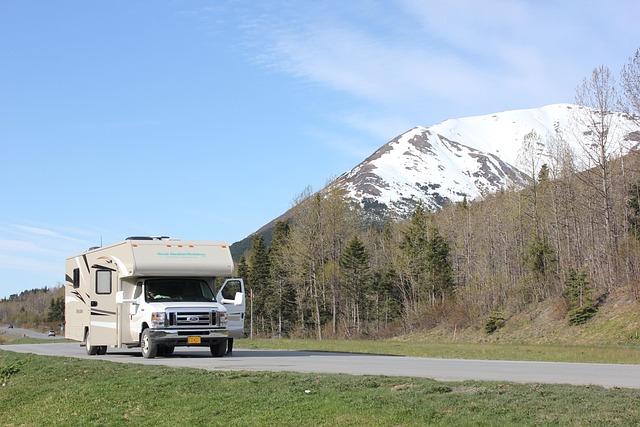RVing for Beginners involves a methodical approach to ensure a comfortable and secure camping experience. Begin by selecting a campsite that's flat, clear of obstructions, and has room for your RV with all necessary facilities. Once settled, level your RV using available tools to prevent damage and ensure functional stability. Secure the tires with wheel chocks to prevent movement, especially in windy conditions. Set up essential utilities by connecting to water, ensuring a continuous supply for cooking and hygiene; use a pressure regulator to protect your system. Properly attach the sewer hose to the campsite's outlet, using seals to prevent leaks. Connect to electricity at the correct amp service, using the necessary adapter. Adhere to manufacturer guidelines when setting up these utilities to avoid electrical issues. By following these steps, RVing newcomers can navigate their first camping trip confidently, making their RVing for Beginners experience a smooth and enjoyable one.
Embarking on your first RV adventure? This guide is tailored for novices eager to master the art of setting up camp. With our straightforward, step-by-step approach, you’ll confidently navigate the essentials of RV Camp Setup 101. From selecting your ideal spot and ensuring a level foundation to connecting the vital utilities and amenities, this article equips you with the knowledge to create a comfortable and safe retreat in the great outdoors. Dive into the world of RVing for Beginners and transform your journey into a seamless experience.
- RV Camp Setup 101: A Step-by-Step Guide for RVing Beginners
- Choosing Your Perfect Spot: Leveling and Securing Your RV
- Connecting Essentials: Utilities and Amenities for Comfort and Safety
RV Camp Setup 101: A Step-by-Step Guide for RVing Beginners

Embarking on your first RV camping adventure can be both exhilarating and daunting, but with a clear step-by-step guide, the setup process becomes manageable for RVing beginners. The key to a successful trip lies in meticulous preparation and understanding the mechanics of your RV. Begin by choosing a suitable campsite that accommodates your vehicle’s size and offers necessary amenities. Once you’ve arrived at your destination, leveling your RV is paramount for comfort and safety. Use the onboard leveling system or a bubble level to ensure your RV is even from side to side and front to back. This step prevents interior damage and ensures appliances function properly.
Next, connect your RV to the necessary utilities: water, electricity, and sewage systems. Connect the water hose to the city water supply or your freshwater tank, and test for any leaks. Then, secure the electric hookup, ensuring it’s tightly connected to avoid power surges. For sewage, attach the sewer hose to the RV’s waste outlet and the designated site drain. It’s important to manage waste responsibly, following the campground’s guidelines. Once utilities are set up, deploy any slide-outs if your RV has them. This provides more living space and can make your stay more comfortable. Afterward, proceed with setting up your awning for additional shade or shelter, and familiarize yourself with the RV’s interior features, including propane systems, air conditioning, and heating units. Take time to understand how each system operates to maximize your comfort and safety throughout your camping experience. With these steps in place, you’re well on your way to enjoying a seamless and memorable RV camping trip for beginners.
Choosing Your Perfect Spot: Leveling and Securing Your RV

Embarking on your first RV adventure can be both exhilarating and daunting, but with a few simple steps, you can ensure your camp setup is as comfortable as it is secure. Choosing your perfect spot is crucial for the enjoyment of your trip; look for a flat area away from low-hanging branches and water runoff points to avoid potential damage or discomfort. Once you’ve selected your site, leveling your RV becomes essential for both safety and functionality within your living space. Use your RV’s built-in leveling system or a bubble level to ascertain whether your RV is perfectly horizontal; an uneven RV can cause interior fixtures to malfunction or doors to jam. If your RV requires adjustment, drive the wheels positioned on the low side into blocks of wood or sonotubes to lift and level the unit. Don’t forget to secure your RV by chocking the tires to prevent unwanted movement during strong winds or when entering and exiting the vehicle. By following these steps for leveling and securing your RV, you’ll lay a solid foundation for a successful and enjoyable RVing for Beginners experience. Whether you’re new to RVing or a seasoned traveler, setting up camp with care and attention to detail will enhance every aspect of your journey.
Connecting Essentials: Utilities and Amenities for Comfort and Safety

As an RVing newcomer, setting up your camp with the right utilities and amenities is crucial for both comfort and safety. Your RV should come equipped with the essentials, but you may need to connect external services to enhance your stay. To begin with, securing a water source is fundamental. Most campsites offer water hookups; ensure your RV’s water hose is properly connected to this supply. This will allow you to have running water for cooking, cleaning, and personal hygiene. It’s also wise to understand how to use your RV’s water pump and ensure that your water pressure regulator is in place to prevent damage from high pressure.
Next, setting up your sewer and electric connections is equally important. For waste management, the sewer hose should be connected to the designated outlet at your campsite. It’s imperative to use the appropriate seals to prevent leaks and ensure a tight fit. As for electricity, you’ll want to plug into the campsite’s electrical pedestal, which typically offers 30 amp or 50 amp service. Make sure you know which service your RV requires and use the correct adapter to make the connection. This will power up your RV’s lighting, appliances, and electrical systems, ensuring a comfortable and powered environment. Always follow the manufacturer’s guidelines for connecting these utilities, and never exceed the recommended amp capacity of your RV’s electrical system. With these connections in place, you’ll be well on your way to an enjoyable and hassle-free camping experience as an RVing beginner.
Embarking on your first RV camping adventure can be both exhilarating and daunting. This guide for RVing beginners has illuminated the essential steps to confidently set up camp, from choosing a suitable spot that aligns with your preferences, to ensuring your RV is properly leveled, secured, and connected to all necessary utilities and amenities. With these clear instructions at hand, you’re now equipped to embrace the open road with ease. Remember, the journey of RVing for beginners is a learning experience, and with each setup, you’ll refine your skills. Happy trails and enjoy the freedom and comfort that RV living offers!
